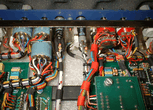There are 3 major catagories involved in ISA repairs:
Capacitors – Typically ISA units are 15 or more years old. Depending on the usage, most of the electrolytic material used in the capacitors has dried up, causing the caps to go partial or fully open circuit. The frequency response and level will suffer as these caps continue to age.
Potentiometers – Even though Focusrite uses the finest plastic conductive pots available, they will become dirty. Over the past 10 years of repairing Focusrite equipment, we have tested every known cleaning process. The ONLY successful method we have found is to REPLACE them – period.
Switches – There are two types of switches used on ISA units – push and rotary. Due to the frequency of use, and physical mounting of the switches between the front and sub panels, the push switches are prone to cracking. The orginial ITW push switches are no longer available, however the currently used EAO push switches will fit all the old units with a minor wiring change. You must replace not only the switch but also the switch cap as the ITW and EAO ones are not compatable.
As for the rotary switches, Focusrite discontinued using the Swiss-made ELMA switch in favor of the US made Grayhill switch years ago. In time most if not all of the blue bodied ELMA switches become dirty and cause many intermittent signal problems. You may experience distortion, drops in level, noise and even oscillation depending on which pole of which switch starts to fail. Once again we have tried unsucessfully over the years to clean them, so now we advise ONLY one cure – REPLACEMENT.
Re-Caping – We thoroughly check each unit for level and frequency response. If the unit does not meet the factory specifications it is time to re-cap it. In order to retain the sonic integrity of the original Focusrite unit, TRD replaces all electrolytic capacitors with the EXACT same Farad value capacitor. In addition, we upgrade them to a higher temperature rating (+105deg C vs +85deg C) to extend the useful life of the capacitor.
Re-Poting – We turn each and every pot individually, while monitoring via an oscilloscope and headphones to detect any trace of “scratchiness” or signal loss. If any signal loss is detected, that pot is replaced with a brand new SFernice plastic conductive potentiometer. In order to achive the factory specifications from when the unit was new, all pots are imported directly from Focusrite UK. In the majority of cases, due to the age of the units, ALL pots are replaced.
Re-Switching – On an ISA unit, the push switches are NOT actually passing audio, but only switching a relay. Therfore, dirty switches are not an issue; however, a cracked switch body will warrant replacement. We individually try to move the switch body from the rear of the switch with a finger. If the switch moves, this means there is a crack in the plastic body (often times under the round knurled switch nut) and we replace it. If the unit is moved from studio to studio in a rack, you can almost bet that the majority of switches are physically broken, even though it won’t be noticeable from the front.
Usually, the rotary switches are the cause of most problems on ISA units, and unfortunately they are the most expensive to replace. Again, we turn each and every switch individually while monitoring via an oscilloscope and headphones to detect even a small trace of intermittent signal loss or distortion. Any deviation in the signal requires replacement. On newer units such as the ISA-215, the rotary switches are wire to wire direct replacement. Even older 215’s with the blue ELMA switches can be easily upgraded to the new Grayhill switches. However 110’s, 115’s, 130’s and 131’s require a lot more than just replacing the switches. These units have the wires harnessed and dressed into the switches with absolutely no extra slack in the wire. The wires on the back sections of the blue ELMA switches will NOT reach to the back section of the new GRAYHILL switches. Therefore the wires must be extended – a messy proposition. Instead of extending the wires, we at TRD make new switch looms with the original specification British wire, which we import directly from the UK. In addition, to retain the look of the original factory wiring, we do not use heatshrink. We only use rubber Hellermann sleeves, also imported directly from the UK.
Take a look at the pictures below to see examples of our work.
Click on images for larger view
|
Filter and EQ Select Switches
|
Mic and EQ Select Switches
|
||
|
Original Wiring
|
TRD Wiring
|
Original Wiring
|
TRD Wiring
|
Click on images for larger view
|
Close up of Filter Switch PCB Wiring
|
|
|
Original Wiring
|
TRD Wiring
|
Click on images for larger view
|
Center View
|
Filter Switch
|
Mic Switch
|
|
Old vs New
|
Old vs New
|
Old vs New
|








